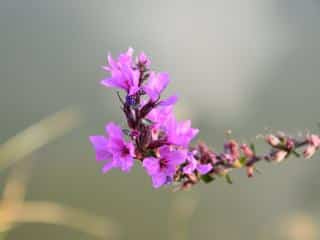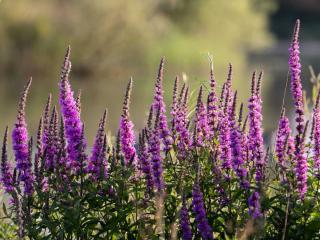

With its tall pink stems, purple loosestrife adorns water edges. It also boosts our well-being with its medicinal properties. Dive deep into the benefits of Lythrum salicaria and check out our growing tips!
→ Similar, but different: Astilbe

This perennial thrives in damp environments. You’ll often find it near water. It grows to about 3 feet (1 meter) high. With lance-shaped green leaves running along its stem, its underside is lighter than the tips.
Above these upright stems filled with leaves, flowery spikes emerge. Blooming starts in June and runs through to October, keeping gardens lively all season long!
Producing nectar and honey, it serves as a feast for pollinating insects.

This plant boasts anti-infective, antifungal, anti-inflammatory, analgesic, and astringent benefits.
It can also boost blood insulin levels, making it a diabetes remedy. Externally, it aids healing.
For diarrhea, prepare up a decoction using 0.35 ounces (10 grams) of dried salicaria. Mix the plant with 1 quart (1 liter) of boiling water. Boil for 10 minutes, then let it steep as it cools. It’s best to drink two to three cups daily.
This time, dilute 50 drops in a glass of water. Repeat thrice daily for up to two days.
Apply powder directly to wounds or ulcers struggling to heal.

As for sun exposure, whether you have a spot in full sun or partial shade, it’s all the same to your purple loosestrife.
So how do you plant your newly-bought nursery pots? What matters is to keep plants about 20 inches (50cm) apart. Generally, planting many in a wide patch gives you a dense and blossoming carpet of beauty.

Every spring, it’ll be grateful for a good dose of compost or slow-release fertilizer. As blooms wilt away, snip off the flower spikes to avoid unscheduled reseeding.
Once the first frost hits, it’s seed collecting time. You’ll have to stratify them during winter to make sure they sprout in spring.
This is called stratification, simulating winter to ensure robust sprouting. Come next spring, you’re good to sow those seeds once temperatures rise above 59°F (15°C).
There’s also another way: just divide its clump. Pull a plant out, split it in half with a spade, and voilà! You’ve got two new plants. Best done in spring.